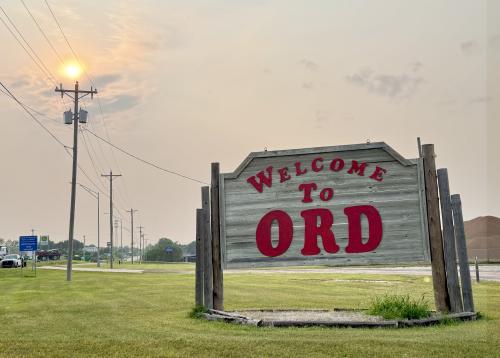In the latest episode of the Reimagine Rural podcast, Tony Pipa, senior fellow at Brookings Center for Sustainable Development, travels to Ord, Nebraska, where the Valley County Health System serves as both a civic and economic anchor in the town’s long-standing renewal. In this expert Q&A, Tony speaks with Tyler Malone, deputy director of the North Carolina Rural Health Research Program at University of North Carolina’s Cecil G. Sheps Center for Health Services Research, about how rural hospitals shape local development and well-being; the financing models and federal policies that sustain them; what evidence says about modern facilities, recruitment, and patient perceptions; trends in closures and risk; and the promise of regional networks like the Nebraska High Value Network.
This conversation has been lightly edited for clarity and brevity.
Tony Pipa (TP): How did you come to be a researcher focused on rural health systems? What motivates you to do this work?
Tyler Malone (TM): I grew up in the country outside Farmer City, Illinois. The name probably gives it away, but Farmer City is a small rural town of about 2,000 people. The claim-to-fame legend says that we were once featured on Sesame Street. I don’t know if that’s true, but in addition to growing up in Farmer City, both my parents grew up on small family farms. I was in FFA and 4-H growing up.
I had and still have a lot of love for my hometown and rural upbringing. I’ll be honest, I did not anticipate having a career in rural health when I was going through high school or even my undergrad studies—shout out to Illinois State University. It wasn’t until my graduate studies at the University of Michigan as a biostatistics student that I began doing public health research. I worked on several research projects and became interested in applying math, biology, and biostatistics to public health topics.
It might have been serendipity, but soon after I began my Ph.D. program at the University of North Carolina, I joined the North Carolina Rural Health Research Program as a graduate research assistant. From that moment on, I loved doing research that I had a personal connection with. After I finished my Ph.D. journey, I became a full-time research investigator at the Rural Program and haven’t stopped since.
TP: How do rural hospitals intersect with economic and community development and overall well-being in rural communities?
TM: We often talk about rural hospitals being pillars of the community. Clearly, there is an essential role that hospitals play in meeting the health care needs of the local population, but there’s also strong evidence to suggest that hospitals have an important economic impact.
One way we study this is by examining how economic indicators in a community might change before and after a hospital closes. Since 2005, nearly 200 rural hospitals have closed. In general, analyses of these closures have shown that there are adverse effects on outcomes like local income, population size, and unemployment rates.
There are also signs that hospital closures can have spillover effects on employment sectors outside of health care. If a local hospital closes, that potentially means fewer jobs in information technology, research, and construction. The value of hospitals extends beyond health care in a lot of cases.
TP: What are the key elements of financing for a rural hospital like Valley County Health System, and how does federal policy shape them?
TM: Rural hospitals can be broadly divided into two major financing models. The first model includes Prospective Payment System hospitals. The second model includes Critical Access Hospitals. Valley County Health System is part of that second group. The Critical Access Hospital designation is provided by the Centers for Medicare and Medicaid Services (CMS). So this is where federal policy comes in.
To be a Critical Access Hospital, the facility has to participate in the federal Medicare program, be in a state that has a Medicare rural hospital flexibility program and be located a certain distance away from the next closest hospital—hence “critical access.” There are limits on the number of inpatient beds and the patient’s average length of stay, and Critical Access Hospitals have to maintain 24-hour emergency care services.
To meet those regulations, critical access hospitals receive financial benefits such as cost-based reimbursement from traditional Medicare. And in general, critical access hospitals receive inpatient reimbursement equal to 101% of allowable costs.
TP: So … it’s complicated.
TM: Yes! There’s a long list on CMS’s website for all the regulations that go into the Critical Access Hospital Program, but this is a program that’s been around since 1997, and empirical evidence would suggest that it does an important job in helping maintain the financial performance of these hospitals.
TP: In Ord, we heard how the local residents voted to approve a major bond issuance to build a new hospital 15 years ago. How essential are local financing tools—like a sales-tax levy or hospital bonds—for building and equipping a hospital, beyond ongoing service costs?
TM: Actually, local financing is relatively rare as a source of capital for rural hospitals. It’s not to say it doesn’t exist, but it’s particularly rare if it’s the sole or the major source of capital. The example you cited shows that the Ord model can work, but investing in new hospital facilities and equipment doesn’t necessarily have to be brought about through local financing options. Also, pushback on local tax increases [by local residents] and limited philanthropic donations are important considerations.
If a community is interested in upgrading an existing hospital in financial distress, then there may be limits to how much the local population is reasonably able to help. Instead, many investments in new hospital facilities rely on a diversity of funding sources. Think of grants, federal loan programs, and contributions of local donors. We don’t want to minimize local contributions, but it’s often a diversity of funding sources that comes into play when building a new hospital or upgrading an existing facility.
The Rural Health Information Hub has a really helpful webpage that summarizes existing grant and loan programs, including those from the USDA, the Administration for Children and Families, and the Economic Development Administration. It does a nice job of summarizing how the efforts required to build or update an existing hospital facility often come from this diversity of sources and, so to speak, it takes a village.
TP: Stepping back, how do rural residents typically view their hospitals, and what builds durable community support to sustain and improve local health infrastructure?
TM: Earlier, I described the dual medical and economic importance of rural hospitals. There’s also this key element of civic pride, independence, and self-sufficiency that are really strong traditional principles in many rural communities. Rural hospitals assist in maintaining those foundations, particularly in frontier areas where the next closest hospital might be literally hours away.
The local hospital can be that beacon of independence and self-sufficiency. And it’s nice to hear about instances of strong civic engagement, like these topics that are going to be directly pertinent to the health and well-being of Ord and other rural communities.
As an aside, one of our research program’s key areas of focus is the tracking of rural hospital closures. There are lots of elements we consider when estimating financial distress or closure risk, but one factor that can be missed in statistical models is the ability of communities to rally around a struggling hospital and alter its trajectory.
Resident engagement that benefits the local hospital takes lots of forms. Using available hospital services for routine care and direct fundraising play an important role, as do advocacy efforts with local, state, and federal policymakers. Many times, maintaining the presence of high-quality rural health care requires cooperation between hospitals, health care facilities, the local population, and state and federal leaders to identify and meet the unique needs of each rural community.
TP: As we talked to leaders in Ord, it also seemed as if having a relatively new hospital counts for something. What does the evidence say about whether newer, modern hospital facilities improve service delivery, patient perceptions, recruitment/retention, and financial performance in rural settings?
TM: In rural research, there’s a term called bypass that refers to an instance when a patient doesn’t visit their closest local hospital, but instead bypasses or receives care at a different facility located farther away. And this is something we study a lot. What goes into bypass? Why does one patient bypass and another one doesn’t?
There are lots of reasons why a patient might bypass, such as physician referral patterns, patient history with a particular provider, etc. Sometimes the reason for bypassing does come down to service offerings or new technology. If a given service line is not available at a particular hospital, a patient seeking that service will obviously have to bypass and go elsewhere.
Rural hospitals often must strike this pretty challenging balance between offering a set of services that meets local community needs and attracts new patients, but they also have to make sure not to overextend and risk financial distress. Outside of service offerings, evidence suggests that upgraded facilities can improve patient perceptions of care if these facilities are tied to improved aspects of the hospital environment.
Factors including quietness of the facility or cleanliness can add up when it comes down to a patient’s takeaway perception of, “how was my care when I visited a given hospital?” There’s also this important bi-directional aspect to these relationships, where improved patient perceptions can increase patient recruitment, which in turn improves hospital financial performance, which may subsequently lead to expanded service offerings.
TP: How would you describe the current state of rural hospitals and the broader rural health care infrastructure in the U.S., given the roughly 200 closures in recent decades?
TM: One of the central ongoing challenges for rural hospitals is the tricky balance between offering a set of services that meet local community needs while making sure that you are also providing services with adequate patient volume that won’t jeopardize the long-term sustainability of the hospital.
There’s a spectrum of financial vulnerability. There are lots of rural hospitals in strong financial positions. I think sometimes that’s lost in the national conversation. There are also facilities that are struggling financially relative to their peers.
And that’s where it becomes important to consider local, state, and federal policies that could potentially assist these hospitals that might need additional help to make sure that they can still offer those essential health care services while also remaining financially viable.
TP: What portion of rural hospitals would you say are potentially at risk?
TM: In our model that we use to forecast future financial distress risk for rural facilities, we have four relative risk categories: lowest relative risk, mid-lowest relative risk, mid-highest relative risk, and highest relative risk.
Most rural hospitals are in those first three categories. In other words, there’s only a small number of facilities that are ultimately at the highest relative risk of financial distress. Even among those that are at the highest relative risk, it’s important to emphasize the relativity of the measure.
If our research center comes out and says that a given hospital has a high relative risk of financial distress, that doesn’t mean that hospital’s guaranteed to close. We liken it to a blood pressure monitor. If a patient comes into a clinic, and the doctor tells them that they have high blood pressure, that doesn’t mean the patient is guaranteed to have a heart attack. That works as an analogy to what we’re trying to do at rural hospitals. If we say a hospital is at the highest relative risk, it doesn’t mean you’re going to close. It just means that we should monitor this going forward and potentially take steps to help that facility out.
TP: What percentage is in that highest risk category?
TM: In most of our research, there are around 2000 general care rural hospitals, not including specialty facilities. Among these roughly 2,000 rural hospitals, in any given year, we typically estimate there are less than 100 that are in that highest relative risk group. So less than 5%.
TP: For hospitals that have closed recently, what common patterns or primary drivers explain those closures?
TM: This is something that we spend a lot of time thinking about as a research center. Conceptually, we think of a rural hospital closure as an outcome that’s often caused by severe financial distress. Most of the time, this is the main mechanism that triggers that event.
If I can put my accountant hat on, there are two accounting building blocks that are germane to this discussion. Net income, which is total revenue minus total expenses, and equity, which is total assets minus total liabilities. Positive net income or profitability is going to lead to growth in equity and unprofitability is going to lead to a decline in equity.
We can think of unprofitability and negative equity as the first two signs of financial distress. As we go further down that severity scale, it leads to additional outcomes like bankruptcy or ultimately hospital closure. To predict rural hospital financial distress, we consider variables from four different domains: recent financial performance, government reimbursement, organizational traits, and market characteristics.
We have found that each of these domains is relevant to financial distress risk. Our research shows that a hospital’s historical profitability, its liquidity, its costs, its status as a Critical Access Hospital versus a Prospective Payment System hospital, its Medicare outpatient payer mix, its net patient revenue, its system affiliation, and its market poverty rate are all predictors that have the best signal to determine rural hospital distress.
Now, these findings don’t necessarily reflect causal relationships, but still, it’s informative that the most important predictors touched on both policy-related variables—Critical Access Hospital status, payer mix, system affiliation—and variables that are often just inherent challenges of rural health, like patient volume.
TP: How is current federal policy impacting rural hospitals, and what would you say some of the implications might be?
TM: Over the next five years, the biggest piece of federal legislation affecting rural hospitals is likely going to be the Rural Health Transformation Program, also known as the RHTP. The RHTP was brought about as part of the One Big Beautiful Bill Act and authorizes $50 billion in funding.
The notice of funding opportunity just dropped on September 15th, and individual states now have until early November to submit their applications for the RHTP. The RHTP is going to allocate its $50 billion in funding over five years, 2026 to 2030, across all states with approved applications. The first half of that funding, the first $25 billion, will be distributed equally across approved states, and the other $25 billion will be distributed based on selected criteria.
According to the funding announcement, these additional criteria are going to include a given state’s rural population, its proportion of rural health facilities in the state, and the financial situation of certain hospitals in the state, among other factors. Each state is going to have flexibility in how they choose to use their allotted RHTP funds.
CMS has a list of approved uses, and states must choose at least three of those approved uses for their funds. The list of approved uses includes goals related to improving chronic disease management, providing payments to health care providers, promoting consumer-facing technology solutions, supporting access to behavioral health services, and in general projects that are going to support innovative models of care.
Given the state-level flexibility in how those funds can be used, there could be differential impacts of the RHTP across regions of the U.S., and it will be important to monitor how that state-by-state rollout leads to changes in rural patient outcomes and health care delivery.
TP: Who is the actual RHTP applicant—state rural health offices or another entity?
TM: The program is generally designed for individual states to apply; the Governor’s Office may take the lead in many (possibly all) cases. I would also expect State Offices of Rural Health to have a major role in filling out the applications. The exact process will likely differ across the 50 states. The full application instructions can be found at the federal grants website.
TP: There were also changes to Medicaid that the Congressional Budget Office has suggested may result in loss of coverage for millions of Americans. Medicaid covers a disproportionate number of rural residents. Are there particular effects you foresee on rural hospitals and rural health infrastructure?
TM: Federal insurance programs such as Medicaid and Medicare have important roles in the rural health infrastructure. Many patients who are treated at rural hospitals are covered by one or both programs. Therefore, substantial changes to the eligibility criteria for these programs could reasonably be expected to have an impact on hospital operations. However, hospital financial performance is also multifactorial—isolating any direct effect of public insurance eligibility changes on hospital outcomes will require additional data and careful analysis.
TP: How do regional networks—like the Nebraska High Value Network that VCHS joined—help rural providers stay independent, improve care, and relieve financial pressures?
TM: The goal of a rural health network is to support integrated care across facilities located in the same region while also allowing those constituent hospitals to retain their independence. By forming a network, rural hospitals are able to cooperate to address their rural community needs and achieve cost efficiencies through scale.
There are additional benefits. If you’re participating in a rural health network, you have perhaps a better seat at the table for value-based programs and have a greater ability to weather periods of financial distress. So as part of a network, like in the ORD example, rural hospitals can potentially overcome these barriers through shared patient volume. As an independent rural hospital, you can still incorporate as part of a network and share the patient volume.
You are also able to share clinical data and management systems, and those can help the long-term sustainability of smaller independent rural hospitals. Furthermore, if you are part of a network and have additional facilities with aligned financial incentives, this can help ameliorate some of those financial concerns.
-
Acknowledgements and disclosures
Support for this Q&A is provided by Ascendium Education Group. The conclusions and recommendations of any Brookings publication or podcast are solely those of its authors and speakers, and do not reflect the views or policies of the Institution, its management, its other scholars, or its funders. Brookings recognizes that the value it provides is in its absolute commitment to quality, independence, and impact. Activities supported by its donors reflect this commitment.
The Brookings Institution is committed to quality, independence, and impact.
We are supported by a diverse array of funders. In line with our values and policies, each Brookings publication represents the sole views of its author(s).







Commentary
The role of rural hospitals in sustaining community health and development: A conversation with Tyler Malone
September 30, 2025